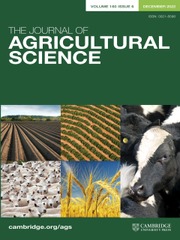Article contents
Tillage under controlled conditions: its effect on emergence and yield of spring barley
Published online by Cambridge University Press: 27 March 2009
Summary
Effects of controlled tillage and soil-water conditions at the time of cultivation on emergence and grain yield were measured for a spring barley crop grown on a silty clay loam soil. A range of soil densities was achieved using conventional implements (tine-cultivator and roller) in combination with three levels of soil wetness. Concrete tracks supported both tractor and implements to prevent compaction due to wheelings, and rain-activated mobile shelters excluded precipitation from the field site.
Tillage treatments had large and significant effects on plant establishment. Both rate of emergence and final emergence were lowest where the soil was rolled at a high moisture content, and greatest where it was cultivated dry. Time for 50% plant emergence, rate of emergence and final plant population density all tended to be linearly correlated with the bulk density of the prepared seed bed. Despite large differences in plant establishment, later compensatory growth caused final yields of grain to show no significant response to tillage treatment.
Information
- Type
- Research Article
- Information
- Copyright
- Copyright © Cambridge University Press 1984
References
- 2
- Cited by

